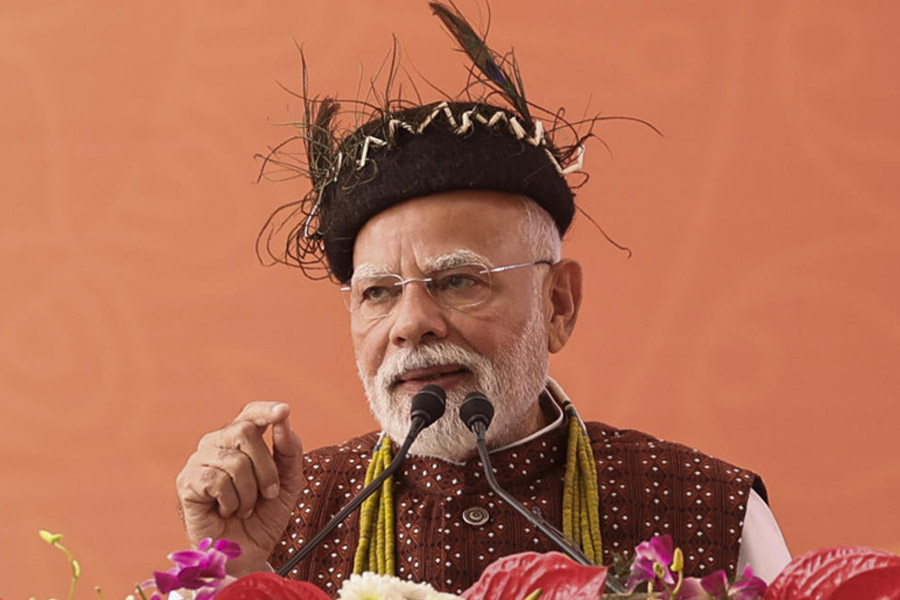.jpg)
Mother Tortoise was coming to visit the butterflies at Eco Tourism Park. The Striped Tigers, the Common Crows and the Great Eggflies were flapping about as usual in the shrubs but their keepers were all aflutter since morning. Not everyday does Lee Durrell, director of the Durrell Wildlife Conservation Trust and the widow of conservation icon and author Gerald Durrell, come visiting.

Pictures by Sudeshna Banerjee
The lady, credited with successful captive breeding of various endangered species including the ploughshare tortoise of Madagascar (to which she owes her sobriquet), was on a visit to the land of her late husband’s birth and the New Town trip had been woven into her packed schedule.
Accompanied by partner Colin Stevenson and local conservation activist Basav Bhattacharya, she walked into Gate 6 of Eco Park around 10.30am but her first meeting at Nature Mates, which runs the butterfly park, was to be a virtual one with snakes, crocs and tortoises, not butterflies.
Herpetologist Anirban Chaudhuri started off by giving her an audio-visual presentation on his captive breeding attempts at Assam State Zoo.
“The zoo lacked expertise for reptile breeding. When we reached, a clutch of Indian rat snakes had just laid eggs. We showed them how to incubate them artificially. For the first time in the zoo, all 11 eggs hatched and were released in their natural habitat.”
Another success story he shared was the artificial incubation of salt water crocodiles that nature mates had undertaken at Bhagabatpur in the Sunderbans. The eggs-to-hatchling ratio at the project since its inception in 1976 was barely 40 per cent. “Despite the lack of electricity and artificial incubation chamber on the island, we managed to increase the rate to 84 per cent in 2015-16. About 70 of the young were tagged and released in the waters.”
But not every attempt has been successful. Bengal, he pointed out, lags in turtle conservation. “Many an endangered species have their natural habitat here, like the Indian flap shell tortoise, which sometimes get rescued. But we know too little about their status or life cycle in the wild to go for turtle breeding,” he said, seeking tips from Durrell.
Arjan Basu Roy, secretary of Nature Mates who runs the butterfly park at Central Park in Salt Lake as well, explained his choice of butterflies for conservation. “If the base is strong the pyramid will be strengthened. If the tiger has to be conserved one should start with the lizard. We release 5,000 to 10,000 butterflies in nature every year,” he said, taking Durrell to the laboratory where butterflies were being incubated from egg to larva to pupa stage. That touched a chord with Durrell.
“Gerry (Gerald) always said that the small creatures are the nuts and bolts of the eco system. But people pay little attention to them. They are only interested in the box office animals.”
She was deeply impressed to see the detailed records being kept. “We can give you season-wise and gender-wise data of the release,” said Basu Roy. “What about mortality figures,” she asked. “We have that both at egg and pupa stage as also the total emergence figures,” he assured her. They also assured her that they were computerising the data and using GPS and GIS maps. Leafing through the data records, she said: “Your desire to record is much a Gerry thing. He used to insist that the staff write everything down even in the 60s when documentation of data was unheard of. Young people now have no clue about natural history. How many eggs should a bird hatch and when, what is the average — our generation knew all these things by going into the forest and checking. We have to get the youth out there.”

She would soon be going out there herself, guided by the park’s lepidopterist Sarika Baidya and Basu Roy. The domed enclosure is shaded by a net which reduces the sunlight by 30 per cent. Inside, Durrell was handed a basket full of butterflies to release. While some fluttered away on their own, others had to be coaxed out. A few settled on her fingertips and would not leave till she blew at them.
She was quite taken with the system of rotten fruits being hung in netted bags in the enclosure. “Some butterflies need fruit sap as nutrient,” Basu Roy explained. “Colin, please take a picture of this,” Durrell urged Stevenson who was clicking away.
.jpg)
.jpg)
.jpg)
There were many more in various hues and stripes outside when she did a walk-through amid the lime and lantana, rangan and karabi plants that butterflies love. “If we create a habitat keeping the basic needs of the butterfly in mind, like source of nectar, availability of larval host plant and proper roosting places, then slowly but steadily the butterfly population becomes residential. Thus they are confined here without confinement,” Basu Roy explained to her.
“It’s brilliant. Wish there were more centres like this,” Durrell gushed to The Telegraph Salt Lake on her way out. “They are planning a butterfly park in Jersey Zoo (run by the trust). She was impressed that we had made such a vibrant garden using such simple means,” smiled Basu Roy.
• Visit the butterfly park as soon as Eco Park opens. Butterflies are hard to come by after 3pm

.jpg)








